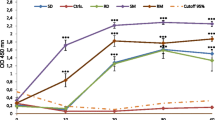Abstract
To find direct evidence for the sites of death of newly transformed schistosomula ofSchistosoma mansoni in the skin of challenged immunized hosts, a histopathological study of the skin of chronically infected mice and of highly X-irradiated cercaria-immunized mice was made at different post-challenge times. Attrition of infecting organisms in naive mice was used as a control. In general, three main kinds of schistosomular attrition were observed: (1) in the granulocytic exudates in the epidermis, (2) in the granulocytic aggregates in the subcutaneous tissue, and (3) in the granuloma-like foci in the subcutaneous tissue. Schistosomula killed by the epidermal granulocytic exudates and by the subcutaneous granuloma-like foci occurred in all three groups of mice, but the schistosomula killed by the subcutaneous granulocytic aggregates were found only in the highly X-irradiated cercaria-immunized animals. Schistosomula killed by the epidermal granulocytic exudates were encountered occasionally in the challenged naive mice but more frequently in both the challenged chronically infected mice and the challenged highly X-irradiated cercaria-immunized mice. The number of subcutaneous granuloma-like foci was greater in the challenged mice immunized with highly X-irradiated cercariae than in the challenged naive mice or the challenged chronically infected mice. Another differentiating character among the three groups of mice was that in the highly X-irradiated cercaria-immunized group, the subcutaneous granuloma-like foci appeared on day 3 after the challenge, but on day 5 in the naive and chronically infected groups. The results clearly indicate that skin is an important site for the attrition of the challenged cercariae in the highly X-irradiated cercaria-immunized mice, and that immunity in the chronically infected and X-irradiated cercaria-immunized mice occurs by different mechanisms.
Similar content being viewed by others
References
Austen KF, Wasserman SI, Goetzl EJ (1976) Mast cell-derived mediators: structural and functional diversity and regulation of expression.In: Johansson SGO, Strandberg K, Uvnäs B (eds) Molecular and Biological Aspects of the Acute Allergic, Reaction. Plenum Press, New York, pp 293–318
Clegg JA, Smithers SR (1972) The effect of immune rhesus monkey serum on schistosomula ofSchistosoma mansoni during cultivation in vitro. Parasitology 80:289–300
Dean DA, Wistar R, Murrell KD (1974) Combined in vitro effects of rat antibody and neutrophilic leukocytes on schistosomula ofSchistosoma mansoni. Am J Trop Med Hyg 23:420–428
Dean DA, Wistar R, Chen P (1975) Immune response of guinea pigs toSchistosoma mansoni. I. In vitro effects of antibody and neutrophils, eosinophils and macrophages on schistosomula. Am J Trop Med Hyg 24:74–82
Hsü HF, Hsü SY, Eveland LK (1980) Schistosomiasis vaccination. Historical development, present status and future prospects. Chinese Med J 93:297–312
Hsü SY, Hsü HF (1978) Further discussion on the new hypothesis for the mechanism of immunity to schistosome infection. Proc Int Conf Schistosomiasis. Min Health Cairo, Oct 1975 2:573–582
Hsü SY, Hsü HF, Penick GD, Lust GL, Osborne JW (1974) Dermal hypersensitivity to schistosome cercariae in rhesus monkeys during immunization and challenge. 1. Complex hypersensitivity reactions of a well-immunized monkey during the challenge. J Allergy Clin Immunol 54:339–349
Hsü SY, Hsü HF, Penick GD, Lust GL, Osborne JW, Cheng HF (1975) Mechanism of immunity to schistosomiasis: Histopathologic study of lesions elicited in rhesus monkeys during immunizations and challenge with cercariae ofSchistosoma japonicum. J Reticuloendothel Soc 18:167–185
Hsü SY, Hsü HF, Isacson P, Cheng HF (1977) In vitro schistosomulicidal effect of immune serum and eosinophils, neutrophils and lymphocytes. Reticuloendothel Soc 21:153–162
Hsü SY, Hsü HF, Burmeister LF, Osborne JW (1979a) Evaluation of lung recovery assay for schistosomula in mice immunized with X-irradiated cercariaa ofSchistosoma mansoni. Z Parasitenkd 59:235–243
Hsü SY, Hsü HF, Penick GD, Hanson HO, Schiller HJ, Cheng HF (1979b) Immunoglobulin E, mast cells, and eosinophils in the skin of rhesus monkeys immunized with X-irradiated cercariae ofSchistosoma japonicum. Int Arch Allergy Appl Immunol 59:383–394
Hsü SY, Hsü HF, Hanson HO (1981) Immunoglobulins and complement in the skin of rhesus monkeys immunized with X-irradiated cercariae ofSchistosoma japonicum. Z Parasitenkd 66:133–143
Incani RM, McLaren DJ (1981) Neutrophil-mediated cytotoxicity to schistosomula ofSchistosoma mansoni in vitro: Studies on the kinetics of complement and/or antibody-dependent adherence and killing. Parasite Immunol 3:107–126
Lichtenberg F von, Sher A, Gibbons N, Doughty BL (1976) Eosinophil enriched inflammatory response to schistosomula in the skin of mice immune toSchistosoma mansoni. Am J Pathol 84:479–500
Lichtenberg F von, Sher A, McIntyre S (1977) A lung model of schistosome immunity in mice. Am J Pathol 87:105–123
McLaren DJ, Clegg JA, Smithers SR (1975) Acquisition of host antigens by youngSchistosoma mansoni in mice: Correlation with failure to bind antibody in vitro. Parasitology 70:67–75
McLaren DJ, Terry RJ (1982) The protective role of acquired host antigens during schistosome maturation. Parasite Immunol 4:129–148
Miller KL, Smithers SR (1982) Localized skin changes at the site of immunization with highly irradiated cercariae ofSchistosoma mansoni are associated with enhanced resistance to a challenge infection. Parasitology 85:305–314
Smithers, SR (1980) Vaccination against schistosomiasis.In Mizrahi A, Hertman I, Klingberg MA Kohn A (eds) New Developments with Human and Veterinary Vaccines. Alan Liss Inc., New York, pp 287–299
Smithers SR, Gammage K (1980) Recovery ofSchistosoma mansoni from the skin, lungs and hepatic portal system of naive mice and mice previously exposed toS. mansoni: evidence for two phases of parasite attrition in immune mice. Parasitology 80:289–300
Smithers SR, Miller KL (1980) Protective immunity in murine schistosomiasis mansoni Evidence for two distinct mechanisms. Am J Trop Med Hyg 29:832–841
Warren KS (1972) The immunopathogenesis of schistosomiasis: A multidisciplinary approach. Trans Roy Soc Trop Med Hyg 66:417–434
Wheater PR, Wilson RA (1979)Schistosoma mansoni.: a histological study of migration in the laboratory mouse. Parasitology 79:49–62
Author information
Authors and Affiliations
Rights and permissions
About this article
Cite this article
Li Hsü, S.Y., Hsü, H.F., Johnson, S.C. et al. Histopathological study of the attrition of challenge cercariae ofSchistosoma mansoni in the skin of mice immunized by chronic infection and by use of highly X-irradiated cercariae. Z. Parasitenkd. 69, 627–642 (1983). https://doi.org/10.1007/BF00926673
Accepted:
Issue Date:
DOI: https://doi.org/10.1007/BF00926673




